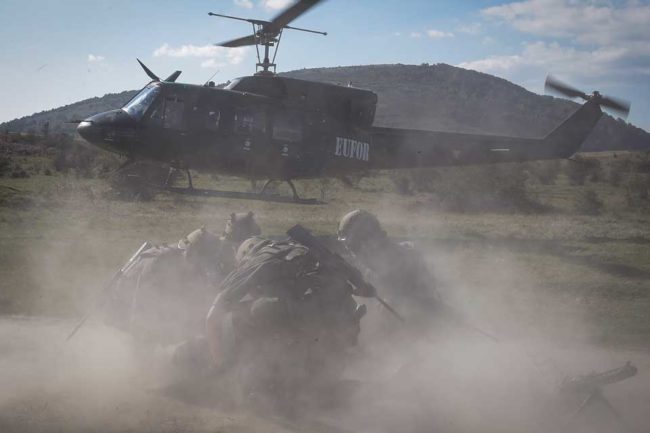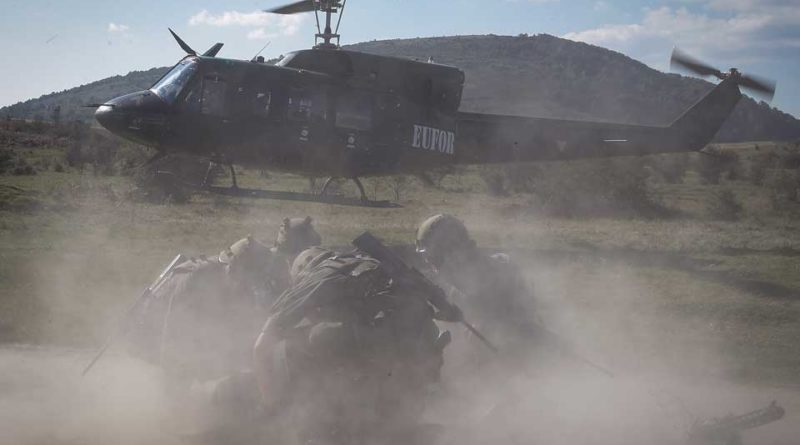A European rapid reaction capability for the evacuation of European citizens?
(B2) The European rapid reaction capability still causes difficulties in being accepted by many European countries. And it raises a natural doubt about its subsequent effectiveness. Shouldn't we take the problem backwards? And look for what could bring Europeans together to intervene rather than what divides them?

Four historical elements
1° European measures that have remained too theoretical
All the objectives and mechanisms that Europe wanted to put in place – such as the objective of 60.000 men defined in Helsinki – have not been followed up. As soon as the objective was set, the process was put in place. But not used afterwards. The NATO NRF didn't really leave when needed either. As for the Eurocorps, which was to be the embryo of this European force, it has remained largely underused compared to the initial ambition.
2° An existing system, which has remained in the harbor
The latest device, battle groups, has never been activated. Not that we have never tried to trigger this rapid reaction force of the EU which normally has 3 to 4000 men on duty available (in fact much less). But at each attempt—we counted six—the conditions, political or military, were never met. And it won't go away until we drastically change how it works.
3° Divergent tendencies remain
Modeling an intervention concept based on totally different, and sometimes even divergent, national interests in political and geopolitical contexts that evolve at different speeds is a game of chance. Elections, resignations, political crises, army reforms, budgetary tensions, various crises... influence the will or the capacity to send troops abroad. To believe that one can create a common strategic culture of peoples and States from a concept on paper is audacious.
4° Current thinking risks being outdated tomorrow
The possible agreement on a rapid reaction capability — within the framework of the strategic compass (1) — still conceals fundamental differences today. Between those who do not want to touch sacred battlegroups, those who try to reinvent them in another other form, those who approve of the project by saying "by 2025" we will see, and those who believe that if reaction of scale it will be made within NATO, today's rapid reaction force could suffer the same fate as the battle groups of yesterday. The time to make the effort to put it in place, the political leaders who will have accepted it will not be far away, the conditions will have changed. And the security context will have evolved.
turn the problem upside down
Rather than building a concept for a possible operation and then seeking an agreement and an ideal compromise, shouldn't we take the subject in the other direction?
Start from the ability to agree
It is not a question of what Europe can do in the face of past, theoretical or future crises. But rather to examine what would lead European countries to be able to intervene whatever the circumstances and to transcend their differences. An event that would act as a magnet to sublimate political reluctance and national conditions of engagement. If we look well into the past (and into the future), there is only one circumstance that meets all the conditions: when European citizens are in danger somewhere in the world - for whatever reason (conflict, disaster, epidemic, etc.) and that they must be repatriated and evacuated.
A not uncommon hypothesis
This hypothesis is repeated regularly, almost every 2 or 3 years if we count correctly: from the tsunami in Southeast Asia in 2004 to the Covid-19 epidemic in 2020, via the Bombay attack, the the rebel offensive in Chad or the Russians in Georgia in 2008, the earthquake in Haiti in 2010, the Ebola epidemic in 2014, not to mention the mega-evacuation from Afghanistan in the summer of 2021. Each time, a mechanism has to be reinvented. Because the managers of the previous crisis are no longer there. Despite the existing reconciliation mechanisms, each evacuation is thus a gamble.
Success depends on organization
Things are going rather well (Chad 2008, Evola 2014, Afghanistan 2021), sometimes worse (Georgia 2008), or even very badly (Bombay 2008, read: The evacuation of Europeans from Bombay, the souk, denounce MEPs). And when things go well, it's often because a State has taken matters into its own hands, provided the means and ensured most of the coordination (France in Chad in 2008, the USA in Afghanistan in 2021 ). These successes should therefore not be relied upon to deduce any European capability. Success is linked to good coordination, failure, on the contrary.
Countries ready to act in extraordinary ways
Past crises have proven this. In the event of an emergency, one can dispense with the authorization of parliament, or at least invent mechanisms for express consultation, in accordance with both constitutional and operational conditions. The last crisis proved it. The German A400M planes were already on their way to Kabul, even landing there, when the German deputies were consulted. And no criticism has been made on this point across the Rhine. Quite the contrary.
Europe has all the technical means available
Planes with strategic range (A400M, A310 or A330, C17 planes from the NATO pool), planes with tactical range (A400M, C130J, Casa, etc.), helicopters, ships, trained and trained men. And even an air flight coordination cell (EATC: a model to follow) set up by half a dozen European countries and based in Eindhoven, not to mention the European Commission's civil protection coordination unit in Brussels and the experience of certain countries (such as the Belgian BFast). All of this is operational. It is enough to put all this in coherence, in condition to function and to oversee it at the political level to go quickly.
How to do ?
In my view, all that remains is to provide Europe with a solid evacuation concept, linking the various military elements in place to the political decision.
Work on the concept to connect all the support points
This concept exists, but it dates, must be renovated and redeveloped. A small cell and following the best practices, within the headquarters of the European Union, in Brussels could be responsible for ensuring the coordination of the various means: air of the EATC, military of the Member States, civilians of the European Commission. The civil protection mechanism ensuring the feedback of needs from the different Member States. EATC ensuring, for its part, the concrete regulation of air resources, with the reinforcement of liaison officers from countries that are not members.
Strengthen the political system
The political level could very well be ensured at the level of PSC ambassadors, or even by a videoconference meeting (VTC) of the Ministers of Defense or of Foreign Affairs or of the Interior, depending on the level of the event (conflict, disaster act, terrorist attack or natural disaster within the European Union).
A small ground support force
All that remains to complete the set is to have a small land force, such as special forces, air JTAC or their maritime equivalents, to complete this set. On this project, NATO does not really have a tool and the European Union is fully entitled to act, for the good of the security of the citizens. In terms of financing, a blocking point in most operations, the budget line exists, either at the level of civil protection or of the European peace facility.
An existing legal basis
There is no need to wait to set up this tool. It can go fast. The development of the concept, like the rise in power of a small regulatory unit at the general staff, can be done in a few months. The Union Treaty authorizes such coordination at European level. The adaptation of the political device can follow. You can have a decision for assistance from the European Peace Facility, pre-written, approved, just to be executed. On the civil protection side, this decision already exists, dating from 2016.
A political framework just waiting to be adapted
At the political level, we can have a system with 27 Member States, enhanced cooperation or a project carried out under permanent structured cooperation. It can be backed up by a commitment by the Member States participating in the mechanism to have an emergency mechanism approved by their respective parliaments (which in fact already exists in most countries, either expressly or tacitly). And the political and security committee (PSC) (or another committee) can be formally charged with this task.
Move fast because the next crisis can come quickly
All this requires almost no substantive modification and can be completed in a few months: by the end of June 2022 for the first phase (writing the concepts and the first tests) under the French presidency, by the end of December 2022 (for the operational implementation), under the Czech presidency, or even by the end of December 2023 (for the additional elements), with the special forces. It's urgent. Because an evacuation operation can happen again at any time (in Ukraine or elsewhere). There is no need to wait for 2025! Once this mechanism is in place, has been tested in the field on one occasion or another, we can think about extending it to other crises.
(Nicolas Gros-Verheyde)
- I had already expressed doubts about this force (renowned capacity) of rapid reaction. An idea, far from being revolutionary. A little boldness please. The more the discussion progresses, the less convinced I am.


It is indeed the right approach to start from concrete needs (in the interest of all or part of the 27) on which to develop pre-approved European political solutions, accompanied by modular operational capacities that can be mobilized quickly. I have long supported such an approach for its realism but also because it alone can gradually give Member States confidence in European capabilities (political and military).
It is to generalize this approach that I propose to work on scenarios deduced from the analyzes of the "Strategic Compass" classified by degree of risk and allowing to pre-approve modes of action and associated capacities which will have... finally some chances to be engaged!
If I'm not mistaken, the NEO missions were the first of the said Petersberg missions, but this proposal goes in the same idea of the battle groups or the rapid reaction forces, always waiting for the punctual reactions of the European governments, therefore very difficult to start construction.
I am of the opinion of the creation of a true European force.
https://www.academia.edu/36848418/Una_Brigada_multinacional_plenamente_europea